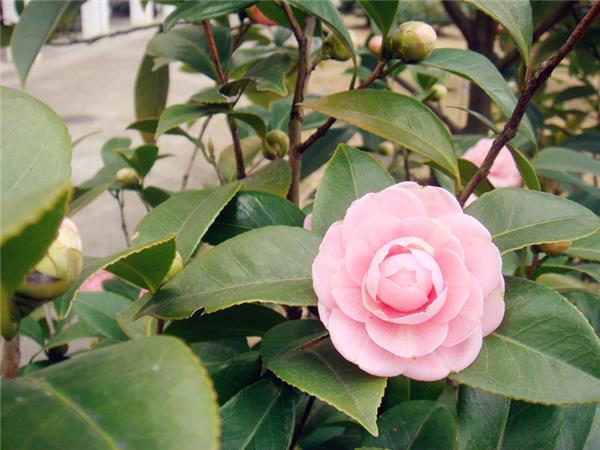[methods of cultivating camellias] Ten points for attention in culturing camellias
Camellia is relatively easy to feed, but in order to ensure its flower quality and ornamental value, we still have to introduce its daily maintenance methods from ten aspects.

Soil: soil is the foundation of camellia growth, all nutrients of camellias are obtained from soil, so the demand for soil is quite high. Generally, the soil contains high humus, PH value is between 5 and 6.5, and is slightly acidic. The best soil configuration is: mountain soil 50%, sawdust or edible fungus residue 40%, cake fertilizer powder or livestock manure and phosphorus fertilizer powder 10%.
Ventilation: the place where camellias grow requires high air circulation, and it is most suitable to grow in the breeze, but camellias are afraid of northwest winds and strong winds, because northwest winds and strong winds tend to make water evaporate too fast, and camellias lose the balance between supply and demand. this is not conducive to the growth of camellias.
Watering: potted camellias should keep the soil moist, but not too wet or too dry. More watering can be done in spring for sprouting and shoots, and early and late watering in summer, it is best to spray foliar water to make the leaves wet through, avoid direct watering and full irrigation with quick water, and avoid watering at high temperature around noon; watering should be appropriate in autumn; watering should be done around noon in winter.

Fertilization: Camellia like fertilizer, potted need base fertilizer, fertilization is mainly phosphorus and potassium fertilizer, fertilizer including mature bone powder, hair, chicken feathers, rice chaff ash, poultry dung and superphosphate and other substances. Usually, it is not suitable to apply too much fertilizer, generally apply 2 or 3 times of thin fertilizer from April to May after flowering, and apply a slightly thicker water and fertilizer in autumn and November. When using fertilizer, we should pay attention to a slightly larger proportion of phosphate fertilizer in order to promote the blooming and colorful flowers.
Humidity: generally dry indoor in winter, should often spray water to the camellia leaves to form a humid microclimate. But avoid spraying water on rainy days.
Temperature: the suitable temperature for the growth of camellias is between 20 and 32 ℃, stop growing when it is more than 29 ℃, and the leaves will be anxious at 35 ℃, which requires a certain temperature difference. The environmental humidity is more than 60%, most varieties can withstand the low temperature of-8 ℃ (natural overwintering, Yuncha is slightly less resistant to cold), and generally can survive the winter naturally in the south of Huaihe River. Like acidic soil and require good air permeability.
Illumination: Camellia is a semi-negative flower, which needs to be shaded by a shed in summer. After the Beginning of Autumn, the temperature dropped and camellias entered the stage of flower bud differentiation, which should gradually make the whole plant receive sufficient light. Winter should be placed in a sunny place indoors. If the indoor light is too weak, the camellias will grow poorly and are easy to get diseases and insect pests.

Turn the basin: many people will ignore this point, many people will not turn the basin once planted, in fact, this is very wrong, camellias generally turn the basin once every two years, to change a large basin, this is conducive to its growth, turning the basin time to pay special attention, it is best in April, when turning the basin to pay attention to, do not remove all the old soil, but also to add a small amount of base fertilizer, and then watered.
Diseases and insect pests: the main diseases of camellias are black mold and anthracnose, which can be controlled by spraying 0.5 degree Bordeaux solution. The main pest is tea shoot moth, and the control method can cut off the insect tip, which is generally carried out from April to June.
Florescence control: because camellias are not cold-resistant, delaying flowering is not commonly used. Generally, the florescence is controlled by means of variety selection, temperature control, hormone treatment and so on. To make camellias blossom, you can use a brush in mid-July or early August to dip 0.1% of gibberellin on the buds, once every 3 days, and normal management of fertilizer and water. If it is estimated that the "National Day" flowering is not safe, it can increase the number of buds, increase fertilizer and water, promote the rapid growth of flower buds, and make the "National Day" see flowers.

The ten items introduced above are the places that must be paid attention to in the process of cultivating camellias. I hope that the above introduction can help you improve the success rate of cultivating camellias.
Related
- Wuhan Hospital Iron Tree Blooming Result Was Instantly Frightened by the Gardener Master
- Which variety of camellia is the most fragrant and best? Which one do you like best?
- What is the small blue coat, the breeding methods and matters needing attention of the succulent plant
- Dormancy time and maintenance management of succulent plants during dormancy
- Minas succulent how to raise, Minas succulent plant pictures
- What are the varieties of winter succulent plants
- How to raise succulent plants in twelve rolls? let's take a look at some experience of breeding twelve rolls.
- Attention should be paid to water control for succulent plants during dormant period (winter and summer)
- Watering experience of twelve rolls of succulent plants
- Techniques for fertilizing succulent plants. An article will let you know how to fertilize succulent plants.



